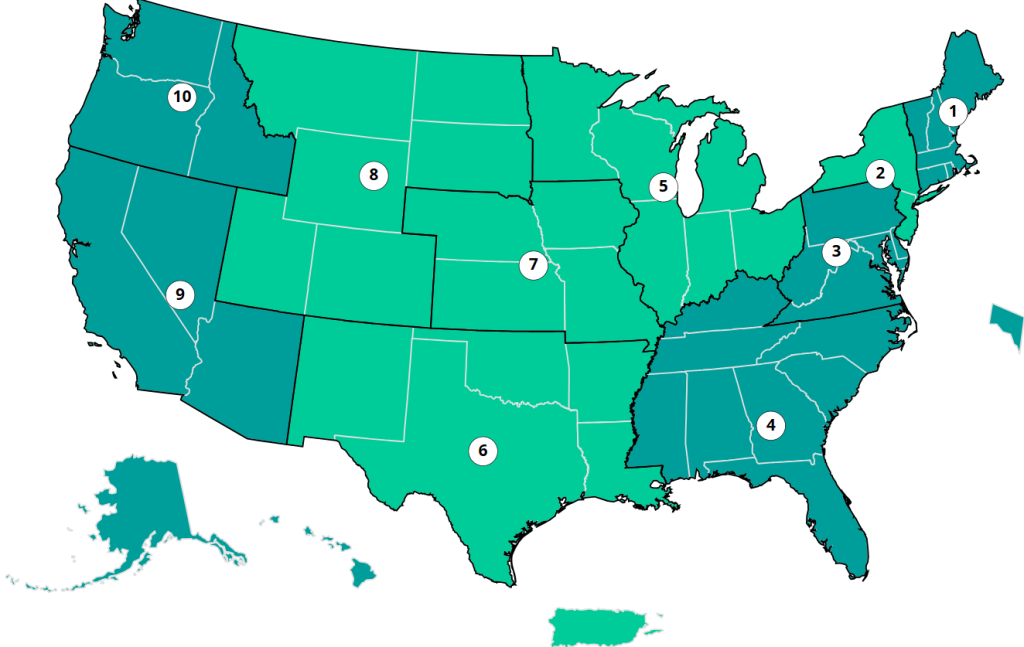The holiday season of 2024 arrives amidst a shifting landscape of COVID-19 infection rates across the United States. While the overall positivity rate remains relatively low, certain regions are experiencing a noticeable uptick in cases, signaling the potential for increased transmission as families gather for celebrations. For the week ending December 14th, the national average positivity rate stood at 5.6%, a slight increase from the previous week’s 5%. This seemingly small shift underscores the virus’s continued presence and the importance of ongoing vigilance. The geographical distribution of these cases reveals a pattern of higher positivity rates concentrated in specific areas. A cluster of states in the Mountain West and Midwest, including Wyoming, Utah, South Dakota, North Dakota, Montana, Colorado, Wisconsin, Ohio, Minnesota, Michigan, Indiana, and Illinois, reported the highest positivity rate at 7.3%. This concentration suggests regional factors, potentially including weather patterns, population density, and adherence to preventative measures, may be influencing transmission dynamics.
Further analysis of regional data reveals a nuanced picture of COVID-19 activity. A swathe of states spanning the South Central and Plains regions, encompassing Texas, Oklahoma, New Mexico, Louisiana, Arkansas, Nebraska, Missouri, and Kansas, registered a positivity rate of 6.6% and 6.3% respectively. This band of elevated positivity highlights the virus’s continued circulation across diverse geographical areas. In contrast, the Northeast, represented by the Virgin Islands, Puerto Rico, New York, and New Jersey, maintained a positivity rate of 5%, aligning with the national average. The remaining states reported positivity rates below 5%, indicating lower levels of viral transmission in these areas. Notably, the Southeast region, including Tennessee, South Carolina, North Carolina, Mississippi, Kentucky, Georgia, Florida, and Alabama, exhibited the lowest positivity rate at 2.3%. This lower rate suggests effective mitigation strategies or other contributing factors may be limiting viral spread in this region.
Beyond positivity rates, other indicators provide insights into the impact of COVID-19 on healthcare systems. Nationally, only 0.7% of emergency room visits were associated with COVID-19 during the week ending December 14th. However, certain states experienced higher proportions of COVID-related ER visits. New Mexico reported the highest percentage at 2%, followed by Kentucky at 1.4%, and South Dakota and Indiana at 1.3%. Several other states, including New Hampshire, Arizona, Wisconsin, West Virginia, Maine, Kansas, Illinois, and Colorado, also reported COVID-19 related ER visits exceeding 1%. These localized increases in COVID-related ER visits, though relatively small in percentage terms, could strain healthcare resources in affected areas, particularly if coupled with other seasonal illnesses. The majority of states reported less than 1.1% of ER visits linked to COVID-19, indicating a lower direct impact on emergency healthcare services in these areas.
Mortality data reveals a fluctuating trend in COVID-19 deaths. While the week ending December 14th saw 254 deaths nationwide, a decrease from the previous week’s 335, this figure still represents an increase from the 179 deaths reported in the week ending November 30th. This fluctuation underscores the dynamic nature of the pandemic and the potential for rapid changes in mortality rates. The CDC’s wastewater surveillance program provides an additional layer of insight into viral activity. Wastewater monitoring, which detects viral shedding in infected individuals’ feces, offers an early warning system for potential surges in infections. Currently, New Mexico, Kansas, and New Hampshire exhibit very high levels of SARS-CoV-2 in their wastewater, while the national wastewater viral activity level remains moderate. This data highlights localized areas of concern and underscores the importance of continued monitoring to anticipate potential outbreaks.
The context of these current trends is shaped by the historical impact of the COVID-19 pandemic. Since the WHO declared a pandemic in March 2020, the virus has infected an estimated 777 million people globally, with a mortality rate slightly below 1%. In the United States alone, over 103 million cases and 1.21 million deaths have been reported, though the actual figures may be higher. The emergence of new variants, coupled with waning vaccine immunity and increased social interaction during the holiday season, contributes to the anticipated rise in COVID-19 cases during the winter months. The CDC recommends that everyone aged six months and older receive a COVID-19 vaccine during the 2024-2025 season to maintain optimal protection against evolving strains. Studies have shown that unvaccinated individuals face a significantly higher risk of COVID-19 mortality compared to their vaccinated counterparts.
Looking ahead, continued monitoring and adherence to preventative measures will be crucial in navigating the evolving COVID-19 landscape. The emergence of new variants, such as the XEC subvariant of Omicron, necessitates ongoing vigilance and adaptation of public health strategies. While XEC is considered more transmissible, its milder symptoms offer a glimmer of hope. Common COVID-19 symptoms, including fever, cough, shortness of breath, sore throat, congestion, loss of taste or smell, fatigue, muscle aches, headache, nausea, vomiting, and diarrhea, often overlap with other illnesses like the flu, highlighting the importance of testing for accurate diagnosis. Experts anticipate a surge in illnesses during the coming weeks, coinciding with the winter season. However, they emphasize that this seasonal increase is not unusual. The CDC will continue to track COVID-19 data and provide guidance based on the evolving situation. Individual actions, including vaccination, testing, and practicing preventive measures, will play a vital role in mitigating the impact of COVID-19 during the holiday season and beyond.


